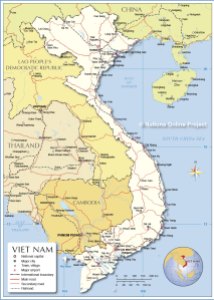For general information about the country profiles click here.
 Population: 88,772,900
Population: 88,772,900
HDI ranking: 127/187
HDI score: 0.617
In the past two decades, Vietnam has tried to devolve authorities to sub-national governments to a large extent. However, implementation of Grassroots Democracy Decree remains uneven and participation in planning at the local level also is often pro forma (World Bank, 2010).
Local governance at a glance
- Vietnam has a three-tier local government structure: provincial, district and commune levels. There are 63 provincial units including 5 cities. The provinces have an average of 9 rural districts and 145 communes, and each commune has 10 – 15 villages (IFAD, 2012).
- There is a representative organ (People’s Council) and an executive organ (People’s Committee) in each of units. “People’s Councils at all levels are elected through universal and equal suffrage and direct and secret ballot” (UCLG, 2008).
- The Ministry of Home Affairs at the center generally has the most responsibility for local government matters (UCLG, 2008).
- There is no legislation that requires a gender quota in urban local government although women have the right to vote and stand for election (UNESCAP, 2001).
Civil society actors include
- Woman’s Union, a major mass organization, is mandated to protect women’s rights and participates in the formulation and supervision of implementation of laws and policies on gender equality.
- The Research Center for Management and Sustainable Development (MSD) is a Vietnamese non-governmental organization that builds competency of Civil Society Organizations (CSOs) and coalitions between Government and CSOs for democracy policy development.
Capacity building institutions
- Public Participation and Accountability Facilitation Fund (PARAFF) is the part of a Danish funded program and supports Vietnamese NGOs through grants and capacity building for better engagement in public participation.
- Association of Cities of Vietnam (ACVN) is a voluntary social organization representing Vietnamese cities and the only organization of local governments in Vietnam.
Fiscal control
- “There has been a major transfer of resources and responsibilities down from the central to sub-national level… Provinces have considerable budgetary autonomy, but their reporting on expenditure back to the central level is relatively weak” (IFAD, 2012).
- In 2002, total local revenue consists of transfer (53.6%), 100% local taxes (24.0%), and shared taxes (22.4%). Local expenditure was 47.7% of total state expenditure (UCLG, 2008).
Key initiatives for participatory local governance
- Vietnam has had three main periods of decentralization. “The first period, 1946-1960, began when the country’s first constitution established people’s councils and administrative committees” (IFAD, 2001).
- The second period was 1960 to 1992 focused on national consolidation and centralizing the administration (IFAD, 2001).
- During the third phase, started from 1996 with vibrant and equitable market economy, the Grassroots Democracy Decree (GDD) of 1998 provided a framework for development of decentralization (IFAD, 2001).
- GDD which called for transparency and participation asks local assemblies to consult residents about decisions (Wescott, 2003).
Challenges for participatory local governance
- Incentives for participatory democracy are weak for citizens and the state currently, so the change to date is superficial rather than real change. New rules and incentives are necessary to improve the quality and quantity of participation (UNDP, 2006).
- Some branches of the Party and local authorities lack understanding and thus lack the leadership for implementation of grassroots democracy regulations. In some units, implementation of the regulation remains formalistic (UCLG, 2008).
Recent posts on this website about this country:
- Increasing public participation through awareness raising activities : a case study in Trao reef marine reserve, Vietnam (2013)
- Local governance and community action : how poor and marginalized people can achieve change (2012)
- DELGO’SEA : partnership for democratic local governance in Southeast-Asia (2012)
- Patient satisfaction with HIV/AIDS care and treatment in the decentralization of services delivery in Vietnam (2012)
- The roles of civil society organizations in enhancing grassroots democracy in Vietnam : a research paper (2012)
- Reinventing rural development in Vietnam : discursive constructions of grassroots democracy during the renovation reform (2011)
- Titling against grabbing? : critiques and conundrums around land formalisation in southeast Asia : paper (2011)
- Local governments and disaster risk reduction : good practices and lessons learned : a contribution to the Making cities resilient campaign (2010)
- Assessing land reform approaches to benefit socially and economically disadvantaged (SED) people (2010)
- Decentralization policies in Asian development (2009)
______________________
List of sources (in order of citation):
World Bank, 2010: “Vietnam Development Report 2010: Modern Institutions”
IFAD, 2012: “Country Program Evaluation”
UCLG, 2008: “Socialist Republic of Vietnam”
UNESCAP, 2001: “Report on the State of Women in Urban Local Government”
IFAD, 2001: “Viet Nam: Country Portfolio Review and Evaluation”
Wescott, C, 2003: “Hierarchies, Networks, and Local Government in Vietnam”
UNDP, 2006: “Deepening Democracy and Increasing Popular Participation in Viet Nam”
